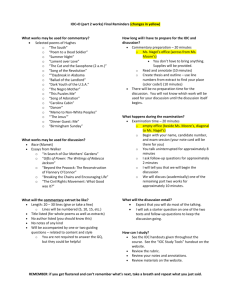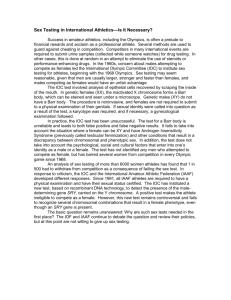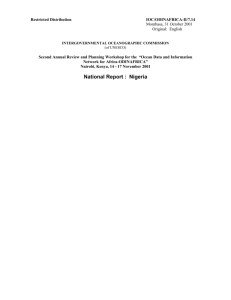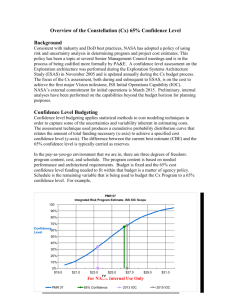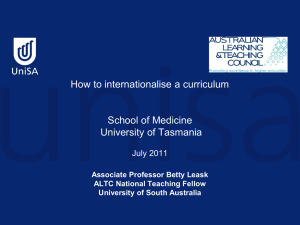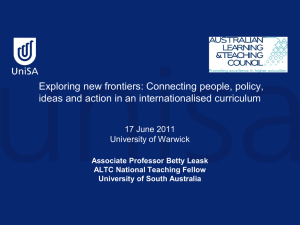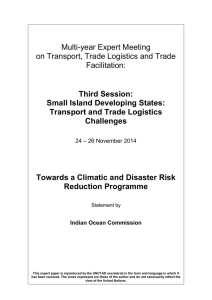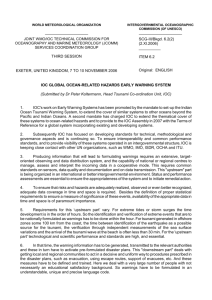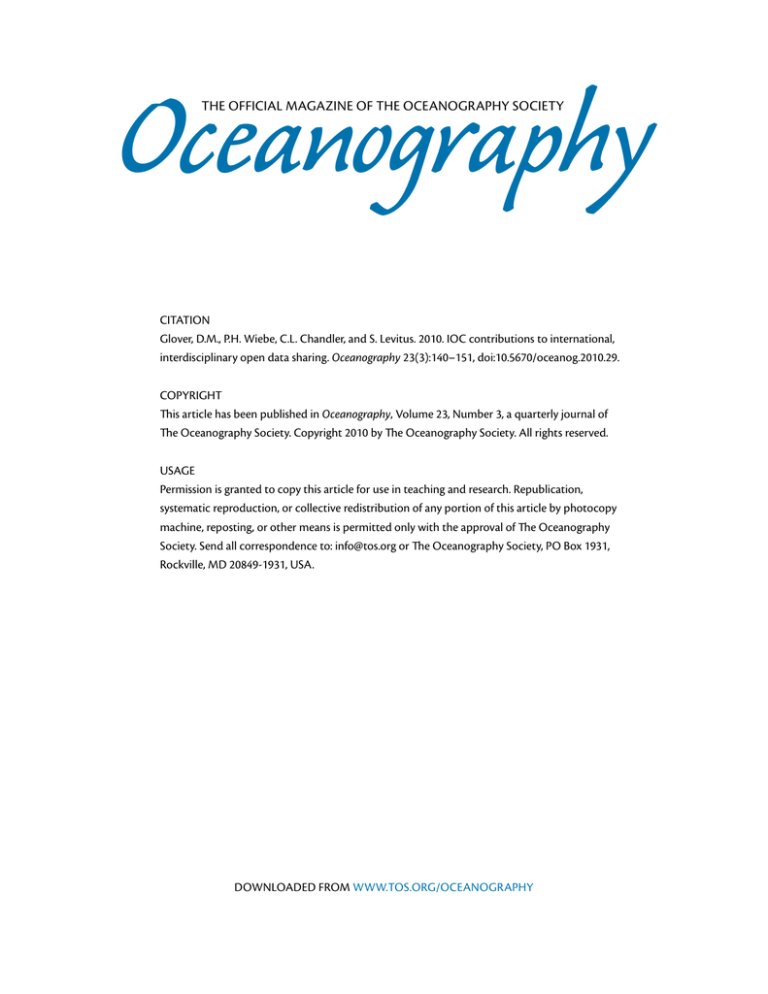
Oceanography
The Official Magazine of the Oceanography Society
CITATION
Glover, D.M., P.H. Wiebe, C.L. Chandler, and S. Levitus. 2010. IOC contributions to international,
interdisciplinary open data sharing. Oceanography 23(3):140–151, doi:10.5670/oceanog.2010.29.
COPYRIGHT
This article has been published in Oceanography, Volume 23, Number 3, a quarterly journal of
The Oceanography Society. Copyright 2010 by The Oceanography Society. All rights reserved.
USAGE
Permission is granted to copy this article for use in teaching and research. Republication,
systematic reproduction, or collective redistribution of any portion of this article by photocopy
machine, reposting, or other means is permitted only with the approval of The Oceanography
Society. Send all correspondence to: info@tos.org or The Oceanography Society, PO Box 1931,
Rockville, MD 20849-1931, USA.
downloaded from www.tos.org/oceanography
C e l e b r at i n g 5 0 Y e a r s o f t h e
In t e r g o v e r n m e n ta l Oc e a n o g r a p h i c C o m m i s s i o n
IOC Contributions to
International, Interdisciplinary
Open Data Sharing
By D av i d M . G l o v e r , P e t e r H . W i e b e ,
C yn t h i a L . C h a n d l e r ,
a n d Sy d n e y L e v i t u s
140
Oceanography
Vol.23, No.3
Introduc tion
Over the last 50 years, the Intergovernmental Oceanographic Commission
(IOC) has had a profound influence
upon the willingness of United Nations
Member States to share and provide
access to their international and interdisciplinary oceanographic data. (For an
early history and review of IOC achievements, see Roll, 1979.) Ocean science
over the last half century has been transformed from a predominately modular,
single-disciplinary, and individualistic
science into a national and multinational
interdisciplinary enterprise (Briscoe,
2008; Powell, 2008). The transformation began slowly, but as computing
power increased, the pace accelerated,
and along with these alterations came
shifts in cultural practices regarding the
sharing of data.
The transformation of ocean science
to a multidisciplinary national and
international enterprise was abetted by
the new availability of a multiplicity of
data sources, thanks, in no small part,
to IOC. Remotely operated vehicles and
autonomous underwater vehicles, floats,
and gliders now complement observations from ships, moorings, satellites,
and manned submersibles (D’Asaro et al.,
2008). Both at sea and in shore-based
laboratories, biogeochemical and genetic
tools and techniques have changed
the nature of the experimental side of
the science. High-resolution coupled
physical, biogeochemical, and biological
models are now used to hindcast with
existing data sets and are setting the
stage for the forecasting needed to assist
in anticipating climate change and
the future management of our planet
(Rothstein, 2006).
To encourage data openness (defined
here as broad accessibility to data
provided by Member States to all others),
IOC has had to face two very real challenges: rapid computer technology
advancement and established national
data cultures. Although IOC is not in the
technology development business per se,
the widely varying state of technological
readiness among Member States (see
Figure 1) dictated the limits of what
could be done as opposed to what could
be imagined. Nevertheless, as technology
evolved, IOC operated at the forefront of
this evolution, doing what it does best—
convincing participants to share their
data for the common good.
The IOC oceanographic data
exchange policy (stated in 1999 as the
11th resolution of the 20th session of
error bounds, and other information).
Although “technology” is a familiar
term, the concept of “data culture” is one
that has received little attention. Data
extracted from nature are much like ore
removed from the earth—problematical
to obtain and as yet unproven in worth.
Later, through the processes of refining,
purifying, and alloying, data, like ores,
become more valuable. Convincing
Member States to share and pool their
data has required (and still requires to
this day) a culture shift in the concepts
of data value and the meaning of the
common good. In this article we explore
the history of some of the obstacles
faced, and present examples of solutions
and benefits provided by IOC efforts
to promulgate an international, interdisciplinary pooling of hard-won data
wrested from the ocean.
the IOC Assembly) subsumes the idea
that data collected in the field have an
intrinsic value that cannot be replaced.
The time-worn saying “you cannot step
into the same stream twice” especially
applies here, considering the time,
energy, and money required to make seagoing measurements. In truth, one only
gets out of a model what one puts into
it. However, you never know what you
are going to find any time you expose a
sensor to the environment. Therefore,
any actual measurement made must be
protected (along with all of the attendant
metadata: where/when was the measurement made, what method was used, who
made the measurement, what are its
IOC’s accomplishments over the past
50 years are numerous, and the notion
that we could summarize the influence
these accomplishments have had on
data openness in a few pages here is
overly optimistic. However, we review
the five decades of IOC’s history from
the early years (1960–1969), through
the middle years, to the latest decade
(2000–present), highlighting key
accomplishments of IOC and its chief
arm, the International Ocean Data and
Information Exchange (IODE). During
each period, we focus on how IOC,
standing at the intersection of technological advances and cultural shifts,
brought about changes in the way the
History
Oceanography
September 2010
141
Copenhagen in July 1960 (see IOC timeline at: http://portal.unesco.org/science/
en/ev.php-URL_ID=8463&URL_
DO=DO_TOPIC&URL_SECTION=201.
html). In effect, this recommendation
not only established the need for an
organization such as IOC, but made
IOC an arm of UNESCO. Then, by
Resolution 2.31 at the 11th session of
the UNESCO General Conference
in November 1960, IOC was made
a reality. IOC’s mission statement
(IOC, 2000) reads:
Figure 1. A plot showing the rise in access to the World Wide Web. The disparity between the
developed and developing world is immediately apparent. That IOC makes allowances for
this discrepancy is one of the strengths of its approach. Here, access to the WWW is being
used as a proxy for access to technology. Source: http://www.itu.int/ITU-D/ict/statistics/ict/
graphs/internet.jpg
oceanographic community in particular,
and the scientific world in general,
shared data. Finally, we speculate about
IOC’s potential future role in data
sharing (Figure 2).
1960–1969: Things Get Organized
In the beginning, data exchange was an
important reason for IOC’s creation.
There were other reasons, including
international cooperation and coordination, capacity building, and sustainable
management of the marine environment. But, during the Cold War of the
1960s, exchange of ocean data was highly
controlled, and it needed a forum for
agreements to be made. In a time when
data were printed on paper, carrying
1
them through airport customs without
declaration was not an option1. This
world was strange to many of us; integrated circuits had just been invented,
allowing the introduction of the IBM 360
“mainframes” and the DEC PDP-8
“mini-computer”—which filled only a
fraction of a large room. There were no
calculators (the slide rule was king) and
Microsoft’s Bill Gates was still in high
school. When it came to data exchange,
much could be imagined, but little (even
for the “developed countries”) could
actually be accomplished.
First, IOC had to be created, and this
was accomplished by a recommendation
from the Intergovernmental Conference
on Oceanographic Research held in
To promote international cooperation and to coordinate programmes
in research, services, and capacity
building, in order to learn more about
the nature and resources of the ocean
and coastal areas and to apply that
knowledge for the improvement of
management, sustainable development
and protection of the marine environment and the decision-making process
of its Member States.
It followed, then, that IOC needed
“arms” of its own to pursue these
goals, especially when it came to the
issue of data. In October 1961, IOC’s
working group on Data and information
Exchange (IOCDE) was established at
the 1st session of the IOC Assembly held
in Paris (headquarters). This working
group was the forerunner of the organization known today as the International
Oceanographic Data and Information
Exchange (IODE). Its purpose was to
enrich scientific marine research, exploitation, and development. IODE was
to accomplish these goals by ensuring
The first floppy disks (eight inches, 80 KB) were invented in 1969, but they were not marketed until 1971. Historical information provided here about computer
technology is drawn from A Brief History of Computing: Complete Timeline by Stephen White, available online at: http://trillian.randomstuff.org.uk/~stephen/history/
timeline.html.
142
Oceanography
Vol.23, No.3
Figure 2. Schematic of the flow of data and information in the IOC data and information management plan (IOC, 2007). Since
publication, this figure has been amended to include the Ocean Biogeographic Information System (OBIS) as part of the
International Oceanographic Data and Information Exchange (IODE) community.
oceanographic data and information
could be exchanged between Member
States. This exchange involved not only
supplying data (i.e., numbers) but also
information products (i.e., knowledge),
even if the Member States were suspicious of the new technology or just
reluctant to part with their hard-won
data. IODE to this day is one of the
programs that still requires intergovernmental agreements and decision
making, so participants at the meetings
are officially designated representatives
of their governments.
These accomplishments might be
thought sufficient for one decade, but
as is often the case, beginnings are
a time of ambition and foresight. In
1967, Ambassador Arvid Pardo of
Malta made an impassioned speech to
the 22nd session of the United Nations
General Assembly (UNGA) that laid the
foundation for negotiations on a new
Law of the Sea. Preparing for and then
making the United Nations Conventions
on the Law of the Sea (UNCLOS)
succeed would be prominent in IOC
agendas through the next two decades.
In December 1968, UNGA adopted
long-term plans for the International
Decade of Ocean Exploration (IDOE),
and the data and knowledge flowing
from that would become a dominant
fixture in IODE during the 1970s and
beyond. At the 6th session of the IOC
David M. Glover (dglover@whoi.edu) is Senior Research Specialist, Woods Hole
Oceanographic Institution, Woods Hole, MA, USA. Peter H. Wiebe is Senior
Scientist Emeritus, Woods Hole Oceanographic Institution, Woods Hole, MA, USA.
Cynthia L. Chandler is Information Systems Associate III, Woods Hole Oceanographic
Institution, Woods Hole, MA, USA. Sydney Levitus is Director, National Ocean Data
Center Ocean Climate Laboratory, National Oceanic and Atmospheric Administration,
Silver Spring, MD, USA.
Oceanography
September 2010
143
Assembly (1969), a general plan was
mapped out for the Integrated Global
Ocean Station System (IGOSS) to permit
collecting and exchanging oceanographic data jointly with the World
Meteorological Organization (WMO).
With no Internet, not even TCP/IP, that
was ambitious indeed.
The name of IGOSS was changed
more than a decade later. As the many
ocean weather stations, which were
the basic data providers to IGOSS,
began to close and data were starting
to come in from vessels of opportunity,
the meaning of the “S” changed from
“stations” to “services.” Thus, the later
name, Integrated Global Ocean Services
System, was adopted.
1970–1979: Data Are “Published”
Computer technology underwent a
growth spurt in the 1970s. This decade
saw the first RAM chip, microprocessor,
and calculator. The UNIX operating
system was developed, as was the
VAX computer and the concept of
virtual memory. The US Department
of Defense was experimenting with
networks (ARPANET), Microsoft was
incorporated, and that greatest of all
computer technology equalizers, the
personal computer (PC) was born. Prior
to this time, data exchange was carried
out by mailing 7- or 9-track magnetic
tape reels. When floppy disks arrived,
it was possible to carry reams of data
(if printed out) in a rather large coat
pocket. Some dreams became possible,
at least for the wealthier nations. Still,
things were missing. There was no DOS
(or Windows), floppies were really
floppy (not durable), and there was
no Macintosh. There was no Internet,
no World Wide Web, and most hard
144
Oceanography
Vol.23, No.3
drives were considerably smaller
than one gigabyte.
But, if the 1960s were the organizing
decade, the 1970s were the years IOC
started publishing data reports and
optimizing mechanisms for international cooperation in the collection and
distribution of marine data. In 1971 at
the 7th session of the IOC Assembly,
the Report of Observations/Samples
Collected by Oceanographic Programs
(ROSCOP) forms were adopted as de
rigueur for all oceanographic research
cruises. Every oceanographer has
had the experience of filling out the
ROSCOP forms as the ship deadheads
back to port at the end of a cruise. At the
same Assembly, IGOSS was organized
into three phases so that by 1975 it
would be fully operational. And, in 1975,
the 9th session of the IOC Assembly
launched the First Global Atmosphere
Research Program (GARP) Global
Experiment (FGGE), a drifting buoy
system that provided meteorologists
and oceanographers the opportunity to
study the ocean/atmosphere as a single,
integrated fluid system. A year later,
IOC, WMO, and CPPS (Permanent
Commission for the South Pacific)
started their El Niño research program.
At the 11th session of the IOC Assembly
(1979), it was decided to co-sponsor an
IOC-Scientific Committee on Oceanic
Research (SCOR) Committee on Climate
Change and the Ocean (CCCO) to
provide scientific advice on oceanographic aspects of the World Climate
Programme (WCP, a WMO project).
A multidisciplinary Marine
Environmental Data and Information
referral system had been adopted at
the 8th session of the IOC Assembly
(1973). It is of particular interest that
this was one of the earliest metadata
systems to be put into practice; the
Ethernet was invented the same year,
although its adoption as the de facto way
to interconnect computers on a local
area network was still decades away.
At the same Assembly session, a joint
IOC/IHO (International Hydrographic
Organization) committee was formed
to provide guidance to the General
Bathymetric Chart of the Oceans
(GEBCO) project. The IOC/IHO
GEBCO project has as one of its goals to
“encourage and facilitate scientific cooperation leading to the exchange and preservation of bathymetric data and associated metadata.” GEBCO is one of the
longest-running ocean data collection
efforts, extending back to its creation in
1903 by Prince Albert I of Monaco and
like-minded geographers and oceanographers. In 1977, IOC oversaw the preparation of a timely report on the present,
planned, and potential uses of satellite
and other remotely sensed marine data
(IOC, 1992) at a time when TIROS-N
(the first satellite to carry the Advanced
Very High Resolution Radiometer),
NIMBUS-7 (Coastal Zone Color Scanner
debut), and Seasat (the first spaceborne
synthetic aperture radar, scanning
multichannel microwave radiometer,
and altimeter) were all a year away from
launch (Kramer, 2002).
With all the previous “organizing”
and “launching,” data started becoming
available. The 10th IOC Assembly session
established the FGGE data processing
center in Germany and a “delayed
mode” data center in the United States.
This was the first time large amounts of
surface drifter data were distributed on
the global telecommunication system
(GTS) of the day. This example of
early data distribution, directly from a
research program, was done in a nearreal-time fashion, sharing sea surface
temperature (SST) and SST anomalies
every five days (Keeley and Taylor, 1982).
The same year, the first volumes of the
International Cooperative Investigations
of the Tropical Atlantic oceanographic
atlases of physical, chemical, and
biological oceanographic data became
available. Also hitting the streets at this
time was the Indian Ocean Expedition
phytoplankton production atlas. IOC
also made plans to put together three
volumes of the GARP Atlantic Tropical
Experiment Oceanographic Atlas.
The 1970s saw a lot of preparation for
the exact interpretation of certain Parts
and Articles of UNCLOS, in particular
Parts XIII (Marine Scientific Research),
XIV (Transfer of Marine Technology),
and Section 76 (definition of the continental shelf). Thus, practical means
were needed to ensure that the rights
and concerns of all Member States were
respected without UNCLOS becoming a
closed door instead of the open window
it was intended to be in providing for
the collection of data the world over.
In particular, the national Exclusive
Economic Zones (EEZs) established
by UNCLOS (Figure 3) for coastal
states would become flash points in
the next decade.
1980–1989:
UNCLOS Impact Is Felt
Computer technology during the 1980s
began to look like it does today. DOS
and Windows appeared, but not at
the same time and not without their
problems (Windows 3.0 would have to
wait for the next decade). Nevertheless,
the personal computer was now placed
on the desktop, for those who had the
wherewithal, with enough computational
power that anyone could have a personal
data center; processor clock speeds
ramped up from around 4 to 33 MHz,
RAM jumped from 1 MB in 1980 to
128 MB by the end of the decade, and
disk storage space exploded from 140 KB
on 5¼-inch floppies to 2 GB partitions on hard drives. The page layout
language Postscript and laser printers
appeared, CD–ROMs were marketed,
and Apple’s Macintosh became available,
turning anyone’s office into a publishing
house with just the addition of relatively small and increasingly affordable
machines. Near the beginning of the
1980s, ARPANET was combined with
TCP/IP and the Internet was born,
global exchanges of e-mail became widespread, and, later in the same decade, the
Internet and Hypertext were combined
to create the World Wide Web (WWW).
All of the major pieces were now on the
board and humankind stood at a critical
crossroad that would determine access to
data. What was needed was guidance.
During the 1980s, technology
advanced to the point that IOC could
give attention to another part of its
mandate, capacity building. In 1982
Figure 3. A map of the world’s Exclusive Economic Zones (EEZs). Although there is plenty of open ocean, it is impossible for a
launching nation to prevent free-floating sensors from being carried into another country’s EEZ by capricious ocean currents. Green
is an approximate indication of the 200-nautical-mile limit, and the gray line represents the continental shelf break. Modified from an
official work published by the Government of Canada from http://www.dfo-mpo.gc.ca/international/dip-rfmo-eng.htm. This graphic is
not produced in affiliation with, or with the endorsement of, the Government of Canada.
Oceanography
September 2010
145
at the 12th Assembly session, IOC
adopted the document Marine Science
and Ocean Services for Development:
UNESCO/IOC Comprehensive Plan
for a Major Assistance Programme to
Enhance the Marine Science Capabilities
of Developing Countries, which established an avenue for IOC to engage in
outreach activities to lift the capabilities
of all Member States to the same level.
“
supported by a comprehensive software
package, GF3-Proc, prepared by IOC
and made freely available to all organizations and laboratories involved in the
international collection, management,
or exchange of oceanographic and other
Earth sciences data.
More accomplishments in getting data
out to the scientific community and the
public followed at the 13th IOC Assembly
IOC’s greatest contribution to data
openness has been in the foresight of the many
participants in allowing each Member State
to contribute as their abilities allowed, all
the while helping them to meet their goals
and add to their capacity.
Following this document’s adoption, in
1985, UNESCO/IOC formulated the
Comprehensive Capacity Development
Plan for Major Assistance Programme
with the purpose of enhancing the
marine science capabilities specifically of developing countries. At the
12th Assembly session, IOC instructed
CCCO to design a comprehensive set of
large-scale experiments for monitoring
the ocean with the purpose of meeting
World Climate Research Programme
objectives. IOC also recommended
the General Format (GF3) be used for
the exchange of oceanographic data
at a time when the media with the
greatest data density for such exchanges
were 9-track tapes (up to 140 MB per
2400 foot reel). The GF3 format was
2
”
session with the printing, publication,
and distribution by the Soviet Union
of the International Bathymetric Chart
of the Mediterranean (IBCM) in 1985.
At that Assembly, Mexico offered to
take an active role in the preparation of
bathymetric charts for the Caribbean
and Central American coastal Pacific.
This Assembly also brought the development of an implementation plan for
IGOSS to accelerate the appropriate
global mechanisms for timely collection
and exchange of standard oceanic and
related meteorological data. At this IOC
session, the Global Sea Level Observing
System (GLOSS) was established under
IOC’s direction and oversight. IODE’s
role was expanded to include Marine
Information Management.
Following on the heels of these
accomplishments were the Tropical
Ocean and Global Atmosphere (TOGA)
program in 1986, the World Ocean
Circulation Experiment (WOCE) in
1987, and the Joint Global Ocean Flux
Study (JGOFS) in 1988. All of these
activities were global in nature, involved
many nations, and collected (for distribution) lots of data. The TOGA program
was a joint IOC/WMO project, with the
international planning office located
in the United States (it continues to
this day). WOCE would go on to plan
a joint IOC/WMO and ICSU2/SCOR
international scientific convention in
Paris in 1988. Its planning office would
be in the United Kingdom, with data
assembly centers (DACs) scattered
around the world. (Some, but not all,
DACs were collocated with national data
centers that were members of IODE.)
Plans to monitor and predict the El Niño
phenomena in the Southeast Pacific were
formulated at this point. In 1987, IOC
joined ICSU’s SCOR to help develop and
implement the marine components of
the International Geosphere-Biosphere
Programme (IGBP). A year later, the
SCOR-initiated JGOFS became part
of IGBP, which provided JGOFS with
an intergovernmental mechanism for
executing plans for five regional process
studies around the world. JGOFS would
have its International Project Office at
the University of Bergen, Norway (closed
in 2003), and the US planning and data
management office was based in Woods
Hole, MA, USA (Glover et al., 2006).
At the 14th session of the IOC
Assembly (1987), the structure of
the working committee (IODE) was
International Council of Scientific Unions (now known as the International Council of Science but with the same acronym)
146
Oceanography
Vol.23, No.3
modified, and its name was changed
to the Technical Committee on
International Oceanographic Data
and Information Exchange, although
it continues to use IODE as its
acronym. Later, at the 15th session of
the IOC Assembly (1989), the idea of
a TOGA Coupled Ocean–Atmosphere
Response Experiment was endorsed
as an indispensable part of TOGA.
The Global Ocean Observing System
(GOOS) concept was developed
jointly with WMO during this period
toward providing an important
piece in the study of the connection
between the ocean and atmosphere for
global climate studies.
The 1980s brought about the Law
of the Sea and the establishment of
national EEZs, instituted by the Third
United Nations Convention on the Law
of the Sea in 1982, which also affected
data exchange practices and politics.
The signing of UNCLOS by Members
States established a legal framework for
ensuring international maritime communications, peaceful use of the seas, and
exploitation of marine resources without
unfair advantage. It further protected
the rights of the Member States to
investigate and preserve the marine
environment and conserve the biological
standing stock.
In the late 1980s, the Global
Temperature Salinity Pilot (later changed
to Profile) Project began under joint
sponsorship of IODE and IGOSS, and
continues to the present. A number of
countries became involved, contributing
data and other resources to what was
deemed the “Continuously Managed
Database (CMD).” Global ocean profile
data circulating on GTS was captured
by the Canadian data center, using
new software to check data quality and
duplications, and files were sent through
Internet connections three times a week
to the US National Ocean Data Center
(NODC), which operated CMD. The
concept was to provide as complete a
data set as possible to a user at any time
from days to years after collection. As
delayed-mode data were received, they
would replace the typically lower resolution and lower quality real-time data.
This project also introduced a standard
for quality control of ocean profile data.
Both the ideas embodied in CMD and
the quality-control procedures strongly
influenced later developments in this
decade and beyond.
1990–1999:
IOC Embraces Global Programs
Computer technology assumed a more
incremental development trajectory in
the nineties, and true multitasking was
added to operating systems. LINUX was
developed and USB support released.
Now it was the time for IOC (and others)
to put that technology to work.
Many of the global programs planned
at the end of the 1980s were relevant
to the study of Earth’s variable climate
system, with the attendant concerns as
to what programs IOC should initiate
to study humankind’s contributions to
that variability. The 1990s began with
the Second World Climate Conference
(WCC2) held in Geneva in October
1990. Here, the international cooperation necessary to support WCP was
underlined, and in order to meet these
global goals, the creation of GOOS
was requested. GOOS later became the
oceanographic component of the Global
Climate Observing System (GCOS).
Implementation of GOOS by IOC
Member States would be accomplished
by government agencies, navies, and
oceanographic research institutions
organized along thematic and regional
alliances in complete cooperation
with each other. In 1991, agreements
were signed between WMO, ICSU,
and the United Nations Environment
Programme (UNEP) to ensure the cooperation necessary in organizing GCOS.
Late in 1990, the United Nations
General Assembly created an
Intergovernmental Negotiating
Committee to review the details of a
United Nations Framework Convention
on Climate Change (UNFCCC) that
would establish the need for stabilizing
greenhouse gas concentrations in the
atmosphere. UNFCCC itself would be
penned at the “Earth Summit” in Rio de
Janeiro in 1992; although it was a legally
nonbinding document (it set no limits
for greenhouse gas emissions), it would
later be updated by the Kyoto Protocol.
At the 16th session of the IOC
Assembly (1991), arrangements were
made to coordinate with the Committee
on Earth Observations Satellites and
national space agencies. At the same
Assembly, IOC chose to co-sponsor
WCP, in particular the World Climate
Research Programme (WRCP) with
ICSU. This arrangement would be finalized in 1992. IOC further decided to
provide a GOOS support office within
the IOC Secretariat to develop GOOS. At
the 17th session of the IOC Assembly, the
Intergovernmental Committee for Global
Ocean Observing System (I–GOOS)
met for the first time. The Training,
Education, and Mutual Assistance
(TEMA) operational fund was also
established at this Assembly to attempt
to guarantee adequate support for the
Oceanography
September 2010
147
TEMA program in the years ahead.
At this same 17th Assembly, the IODE
Global Oceanographic Data Archaeology
and Rescue (GODAR) project was
initialized (Levitus et al., 2005). GODAR,
still underway, has recovered millions of
profiles of temperature, salinity, oxygen,
and nutrients that were at risk of loss due
to media decay (either paper or fading
electronic media). All of these data have
been made available internationally,
without restriction, on DVD and online
(http://www.nodc.noaa.gov) as part
of the World Ocean Database (WOD)
series. WOD is a global collection of
ocean profile data at both observed
and standard levels in one common
format with accompanying metadata
(Figure 4). Boyer et al. (2009) describe
the latest version, WOD09. The importance of such a database to the scientific
community cannot be underestimated.
For example, Levitus (1982) published
the first global analyses of objectively
analyzed fields of temperature, salinity,
and oxygen on a one-degree grid at standard depth levels. This work has been
cited approximately 2600 times, and its
successors, known as the World Ocean
Atlas series, have similarly been cited
a large number of times. These atlases
were made possible by the sharing of
data among IOC Member States through
the IOC/IODE mechanism, recognizing
that no one country can observe the
entire world ocean due to a variety of
resource limitations.
As the 1990s came to a close, the
Figure 4. Distribution of chlorophyll profile data recovered by the Global Oceanographic Data
Archaeology and Rescue (GODAR) project and surface-only chlorophyll data (Levitus et al., 2005).
A red dot indicates a one-degree square containing 41 or more surface chlorophyll observations, orange indicates 21–40, yellow 6–20, and green 2–5. Blue indicates a one-degree square
containing one observation. Note the relative absence of data in the central Indian Ocean, the
eastern South Pacific Ocean, and the South Atlantic Ocean. Data courtesy of the French Ship-of
Opportunity program
148
Oceanography
Vol.23, No.3
20th IOC Assembly began planning
to implement the Global Ocean Data
Assimilation Experiment (GODAE).
This experiment was conceived to help
provide short-term ocean forecasting,
boundary conditions to coastal ocean
forecasting, and seasonal to interannual
atmospheric forecasting (for more information on GODAE, see Oceanography
22(3), September 2009, at http://
tos.org/oceanography/issues/issue_
archive/22_3.html). However, GODAE
has also been useful for comparisons
of global open-ocean models with
data, input into recent global ocean
acidification studies (Xu et al., 2010), and
long-term ocean–atmosphere climate
model integrations. The Argo program
(Roemmich et al., 2009) was accepted
by IOC at this Assembly as an important
contribution to GCOS and GOOS, and
was further considered by IOC as a
major contribution to WCR’s Climate
Variability and Prediction (CLIVAR)
program. All of this was set down in
IOC Resolution XX-6. This Assembly
also formed a Group of Experts for the
Oceanographic Data Exchange Policy,
whose chief task was to reaffirm IOC
policies and principles pertaining to
free and open access to and exchange of
marine data. By 1999, the groundwork
was being laid for formation of the IOC/
WMO Joint Technical Commission for
Oceanography and Marine Meteorology
(JCOMM), an intergovernmental organization dedicated to unifying the activities IOC and WMO had in common.
JCOMM went on to provide coordination, regulation, and management,
as well as data management services
among its international oceanographic
and meteorological members. Today, it
provides an important nexus of expertise
and expedition for international issues of
the day as they pertain to GOOS, GCOS,
and follow-on activities of GODAE.
Throughout the 1990s, issues of
UNCLOS interpretation and implementation arose. In 1995, at the 18th session
of the IOC Assembly, an intersessional
working group (WG) was formed to
examine the relationship between
IOC and UNCLOS, and to review all
articles of UNCLOS that influence IOC
operations either explicitly or implicitly.
In 1997, the 19th session of the IOC
Assembly created a largely unstructured
Advisory Body of Experts (ABE) on
the Law of the Sea (LOS). The main
ABE–LOS responsibility is to provide
advice to IOC on matters pertaining to
the implementation of proposals and
recommendations that have arisen or
will arise from the IOC WG attempting
to formulate IOC’s role in UNCLOS.
Technology not only evolves and
improves, it also spreads. As time went
on, it became more feasible (mostly,
affordable) for developing nations to
integrate into the global Internet. By
the end of the 1990s, it was possible
to propose, review, and accept the
concept of Ocean Data and Information
Networks (ODIN) as an IODE
mechanism for providing national and
regional structure for data exchange
services and products. The first of these
was ODINAFRICA, accepted at the
20th session of the IOC Assembly.
2000–2010:
IOC Promotes Intergovernmental
Cooperation At Sea
In the first decade of the twenty-first
century, there has been a need for even
greater intergovernmental cooperation
at sea, and IOC has tried to broker a
best effort from each of its Member
States, given the heterogeneous nature
of their capabilities. In 2001, the Argo
Information Center (AIC) was established in Toulouse, France. One of AIC’s
purposes is to track Argo floats in order
to alert coastal Member States of their
arrival in EEZs (Figure 5). This center
was the culmination of nearly 10 years
of debate among the Member States as
to what comprises “the right to conduct”
peaceful marine scientific research in
light of the “sovereignty” and “jurisdiction” of coastal states, all terms used
in UNCLOS. The Argo program, with
the near unpredictability of when and
where the floats would be collecting data,
tested the wisdom of having the right to
conduct peaceful marine research and
having exclusive sovereignty of nearby
oceanic regions (EEZs).
At the 21st session of the IOC
Figure 5. Distribution of Argo floats (as of May 31, 2010) in the world’s ocean. Today, over 3000 Argo floats have been released
(given an average lifetime of 3.75 years, approximately 800 floats must be released each year to sustain the desired standing stock of
3000 active floats). Source: http://wo.jcommops.org/cgi-bin/WebObjects/Argo.woa/1/wo
Oceanography
September 2010
149
Assembly (2001), the World Ocean
Database project and the Global Ocean
Surface Underway Data projects were
established and pilot projects were
planned. The World Ocean Database
project has the goals of increasing the
exchange of data gathered in recent
times and the development of regional
atlases. NODC has already published
several such atlases as part of its
“
DC, the 10-year Global Earth Observing
System of Systems (GEOSS) implementation plan was created. The plan
envisioned a sustained GEOSS based on
existing observing systems.
IOC has sponsored activities on
ocean carbon science and observations since the early 1980s, with the
terms of reference for the “CO2 Panel”
evolving each decade to focus on such
With strong support of UNESCO and
IOC by various nations, the oceanographic
community can play its part in a larger
international information warehouse
of Earth data.
”
International Atlas and Information
series (http://www.nodc.noaa.gov). At
the next session of the IOC Assembly
(the 22nd, 2003), the IOC Oceanographic
Data Exchange Policy was accepted by
the Assembly; it states that access to
all oceanographic data collected under
IOC patronage is to be timely, free, and
unrestricted, and include associated
metadata and all derivative products.
This policy is based on a number of
previous data policy statements made
under various IOC/ICSU joint programs.
Regional ODIN networks were also
developed by the 22nd Assembly, in
particular for Africa (ODINAFRICA)
and for the Caribbean and South
America (ODINCARSA), along with
their associated teacher training and
educational outreach activities. That
summer, at the First Earth Observation
Summit (EOS-10) held in Washington,
150
Oceanography
Vol.23, No.3
issues as certified reference materials,
developing a global observing strategy,
or integrating ocean carbon data and
information with the atmospheric and
terrestrial domains. At the 23rd session
of the IOC Assembly (2005), the
IOC-SCOR Ocean CO2 Advisory Panel
was officially renamed the International
Ocean Carbon Coordination Project
(IOCCP) with an emphasis on assisting
research programs with international
data compilation and synthesis activities.
The Surface Ocean CO2 Atlas (SOCAT)
Project, co-sponsored by the Integrated
Marine Biogeochemistry and Ecosystem
Research project and the Surface Ocean
Lower Atmosphere Study, is working
to establish a standard global surface
carbon dioxide dataset that brings
together all publicly available data in
a common format. This compilation
currently offers in a common format
approximately 7.5 million measurements
of various carbon parameters collected
by more than 10 countries during
2100 cruises made from 1968 to 2007. It
is a first level quality-controlled data set.
Also at this assembly, an implementation
plan for the IOC strategy for capacity
building was developed and accepted.
These plans for capacity building had
been around since the 1980s, but finding
an implementation plan to make them
a reality was a while in coming. Lastly,
an International Coordination Group
was formed to plan out an Indian Ocean
Tsunami Warning System.
At its 24th session in 2007, the IOC
Assembly adopted the Ocean Data Portal
Project. This IODE program aspires to
provide seamless access to all oceanographic data held in its network. Further,
members of ABE-LOS were strongly
encouraged to put aside national politics
and continue their efforts to refine the
legal framework IOC relies upon to
ensure that oceanographic data collected
under IOC auspices meet UNCLOS
requirements, especially under Part XIII
(Marine Scientific Research). Eventually,
at the 25th session of the IOC Assembly
in 2009, guidelines to implement
Resolution XX–6 (Accepting the Argo
Project) were promulgated, allowing
for autonomous profiling floats on the
high seas as an important contribution to GOOS, GCOS, and CLIVAR.
Keep in mind the 20th (XX) session of
the IOC Assembly took place in 1999,
and for 10 years, dedicated men and
women gave endless hours of their
time to resolve every perceived inconsistency in UNCLOS wording to make
sure that culture and technology were
finally reconciled. The 25th session also
adopted a resolution to accept the Ocean
Biogeographic Information System
(OBIS), an IOC activity within IODE;
the process to ensure a smooth transition
of OBIS into IOC is underway.
Benefits
The benefits to the global ocean
commons of active and effective IOC
data management and data exchange can
be summarized as:
• Provision of quality-controlled and
properly archived data of many variables measured with documented
current scientific methods, standards,
and formats
• Timely distributions of data (observations) and model output (computa),
as well as attendant metadata and
derived products
• Easy discovery of and access to critical
data, derived products, and forecasts
• Elimination of major barriers to
efficient use and re-use of data;
this ongoing struggle will require
continuous chipping away at the data
sharing cultures that still block an
open data-access world today
No one back in the 1960s could have
predicted the path technology and data
culture would share. IOC’s greatest
contribution to data openness has been
in the foresight of the many participants in allowing each Member State
to contribute as their abilities allowed,
all the while helping them to meet their
goals and add to their capacity.
Conclusion
The future holds large promise as the
oceanographic community stands on the
threshold of a truly global view of the
ocean. Yet, even larger challenges exist.
It is ironic that the rapid development
of technology, which has made so much
possible over the last 50 years, is now
threatening to “balkanize” the World
Wide Web into Nation-Wide Webs.
Today’s technology has given nations
the ability to assert their claim to ownership of outgoing information and to
censor incoming data. Once again, data
culture becomes paramount, and we can
all count on IOC to continue to guide,
promote, and provide for Member States
as each contributes according to its abilities. With strong support of UNESCO
and IOC by various nations, the oceanographic community can play its part in
a larger international information warehouse of Earth data.
Reference s
Boyer, T.P., J.I. Antonov, O.K. Baranova,
H.E. Garcia, D.R. Johnson, R.A. Locarnini,
A.V. Mishonov, D. Seidov, I.V. Smolyar, and
M.M. Zweng. 2009. World Ocean Database
2009, Chapter 1: Introduction. NOAA Atlas
NESDIS 66, S. Levitus, ed., US Government
Printing Office, Washington, DC., 216 pp.
Available on DVD and online at: http://www.
nodc.noaa.gov/OC5/WOD09/pr_wod09.html
(accessed July 25, 2010).
Briscoe, M.G. 2008. Collaboration in the ocean
sciences: Best practices and common pitfalls.
Oceanography 21(3):58–65. Available online
at: http://tos.org/oceanography/issues/
issue_archive/issue_pdfs/21_3/21.3_briscoe2.
pdf (accessed July 21, 2010).
D’Asaro, E.A., C. Lee, M. Perry, K. Fennel, E. Rehm,
A. Gray, and N. Briggs. 2008. The 2008 North
Atlantic Spring Bloom Experiment I: Overview
and strategy. Eos, Transactions, American
Geophysical Union 89(53), Fall Meeting
Supplement, Abstract OS24A-08.
Glover, D.M., C.L. Chandler, S.C. Doney,
K.O. Buesseler, G. Heimerdinger, J.K.B. Bishop,
and G.R. Flierl. 2006. The US JGOFS Data
Management Experience. Deep-Sea Research
Part II 53(5–7):793–802.
IOC. 1992. Guide to Satellite Remote Sensing of
the Marine Environment. Intergovernmental
Oceanographic Commission of UNESCO,
Paris, IOC Manuals and Guides No. 24
(English), 178 pp.
IOC. 2000. Statutes. Intergovernmental
Oceanographic Commission of UNESCO,
Paris, IOC/INF-1148 (English), 41 pp.
IOC. 2007. IOC Strategic Plan for Oceanographic
Data and Information Management (2008–
2011). Intergovernmental Oceanographic
Commission of UNESCO, Paris, IOC Manuals
and Guides No. 51 (English), 42 pp.
Keeley, J.R., and J.D. Taylor. 1982. FGGE atlas
of sea surface temperature and drifting buoy
tracks. Deep-Sea Research 29(5A):659–661.
Kramer, H.J. 2002. Observations of the Earth and
Its Environment, 4th ed. Springer-Verlag, Berlin
Heidelberg, 1,955 pp.
Levitus, S. 1982. Climatological Atlas of the World
Ocean. NOAA Professional Paper No. 13, US
Government Printing Office, Washington, DC,
173 pp., w/microfiche attachments.
Levitus, S., S. Sato, C. Maillard, N. Mikhailov,
P. Caldwell, and H. Dooley. 2005. Building
Ocean Profile-Plankton Databases for Climate
and Ecosystem Research. NOAA Technical
Report NESDIS 117, US Government Printing
Office, Washington, DC, 29 pp.
Powell, T.M. 2008. The rise of interdisciplinary
oceanography. Oceanography. 21(3):54–57.
Available online at: http://tos.org/
oceanography/issues/issue_archive/
issue_pdfs/21_3/21.3_powell.pdf (accessed
July 21, 2010).
Roemmich, D., and the Argo Steering Team. 2009.
Argo: The challenge of continuing 10 years of
progress. Oceanography 22(3):46–55. Available
online at: http://tos.org/oceanography/issues/
issue_archive/issue_pdfs/22_3/22-3_roemmich.
pdf (accessed July 21, 2010).
Roll, H.U. 1979. A Focus for Ocean Research:
Intergovernmental Oceanographic Commission
History, Functions, Achievements. IOC Technical
Series No. 20, UNESCO, 61 pp.
Rothstein, L.M., J.J. Cullen, M. Abbott,
E.P. Chassignet, K. Denman, S.C. Doney,
H. Ducklow, K. Fennel, M. Follows,
D. Haidvogel, and others. 2006. Modeling
ocean ecosystems: The PARADIGM Program.
Oceanography 19(1):22­–51. Available online
at: http://tos.org/oceanography/issues/
issue_archive/issue_pdfs/19_1/19.1_rothstein_
et_al.pdf (accessed July 21, 2010).
Xu, N., D.M. Glover, and S.C. Doney. 2010.
Modeling the potential effects of seasonal variations in seawater carbonate species on calcification. Eos, Transactions, American Geophysical
Union 91(26), Ocean Science Meeting
Supplement, Abstract IT35I-08.
Oceanography
September 2010
151

